Watts 595 - Type WM 3-Way Water Mix Installation guide
- Type
- Installation guide

1
IS-P-595WM
Instructions for Installing
#11 Regulator
3-Way Water Mix (Type WM)
WARNING
!
Read this Manual BEFORE using this equipment.
Failure to read and follow all safety and use information
can result in death, serious personal injury, property
damage, or damage to the equipment.
Keep this Manual for future reference.
Valve Description
The Powers #11 Water Mix Regulator is a self-actuating control
valve which automatically maintains a mixture of hot and cold
water at the desired set point without the use of external power.
Adjust the set point and the rugged self-operating #11 Regulator
controls the mix of hot or cold water to maintain a constant tem-
perature.
The instrument has a vapor pressure thermal system containing
a thermally responsive fluid. This thermal system rapidly senses
temperature changes at the bulb and accordingly positions the
valve disc or plug, regulating hot and cold water flow to maintain
the desired set point. The thermal system features a two-ply
brass bellows with six reinforcing ribs on the bellows head and
thick capillary tubing walls to insure long operating life.
Features
• Tight disc shutoff when either of the two inlet ports are closed
(up to 2")
• EPT disc is replaceable (on 3/4"- 2" valves).
• Lower guide stabilizes valve plug, assisting shutoff and modu-
lation.
• EPT spring loaded V-ring packing provides good sealing and
long life.
• A valve stem of highly polished corrosion resistant grade 316L
stainless steel to decrease friction and reduce hysteresis.
• An adjusting nut mounted on ball bearings and a removable set
point adjusting rod ease set point adjustments
• A set point reference scale aids temperature adjustment
Operation
The #11 Regulator should be installed with the hotter of the two
liquids going into the bottom ‘B’ port and the cooler liquid going
into the upper ‘U’ port.
(A) When the temperature of the mixed liquid drops below
the set point, the temperature of the thermally responsive fluid
decreases, which decreases the vapor pressure in the bulb/
bellows. The force of the resulting vapor pressure is less than
the spring force, so the bellows contract and the spring extends,
which raises the valve plug up to decrease flow through the
Table of Contents
Valve Description....................................1
Operation .........................................1
Applications........................................2
Specifications ......................................3
Sizing and Selection .................................3
Maximum Water Capacities............................4
Product Identification.................................5
Installation ........................................5
Maintenance . . . . . . . . . . . . . . . . . . . . . . . . . . . . . . . . . . . . . . . 6
Preventive Maintenance ..............................9
Troubleshooting.....................................9
Dimensions .......................................10
Parts List.........................................12
Accessories.......................................14
Temp. Ranges/Bulb Sizes ............................14
Ordering Code ....................................15
Warranty Information ................................16
upper ‘U’ port (cold) and increase flow through the bottom ‘B’
port (hot). This raises the temperature of the flow out of the com-
mon ‘C’ port toward the set point.
(B) As the temperature increases toward or beyond the desired
set point, the temperature of the thermally responsive fluid in the
bulb increases, which causes the vapor pressure to increase.
This expands the bellows, compresses the spring, and moves
the valve plug down to increase flow through the upper ‘U’ port
(cold) and decrease flow through the bottom ‘B’ port (hot). This
lowers the temperature of the flow out of the common ‘C’ port
toward the set point.
Temp.
Below
Set Point
Temp.
Above
Set Point
U C
B
U C
B
VAPOR
LIQUID
BULB
CAPILLARY
TUBING
SPRING
BELLOWS
VALVE
PLUG
LIQUID
VALVE PLUG
SEATS
VALVE
PLUG
VALVE PLUG
SEATS
Cold Mixed
Hot
Cold Mixed
Hot
(A) (B)

2
In domestic water system, a safety shutdown device
should be installed in conjunction with a #11 regulator.
Failure of the #11 thermal system will result in a con-
stant rise in temperature (or constant high temperature )
of the fluid which you are trying to control.
Powers #11 Water Mix Regulators are typically used for automat-
ic control of domestic or process water tempering. The self-actu-
ated regulator can easily be installed in any convenient location.
Among its applications are: two-temperature hot water systems,
jacket water cooling of engines or compressors, and many other
industrial processes. Below are two typical applications.
The three-way regulator can also be used for bypass control, in
lieu of a diverting valve, but it must be piped as a mixing valve,
with two inlets and one outlet.
#11 Indicating
Regulator WM
(Water Mix)
Engine
or
Compressor
Pump
Cool Water from
Heat Exchanger
Hot Water to
Heat Exchanger
Bulb in Well
By-Pass
#11 Regulator DS
Double Seat
DIRECT ACTING
#11 Regulator WM
Water Mix
Bulb in Well
Bulb in Well
Steam
Supply
Pump
Pump
Check
Valves
Cold Water Supply
HTHW Return
WATER HEATER
Tempered
Return
HTHW
Tempered
Water
To Condensate Return
WARNING
!
Two temperature hot water system
Jacket Water Cooling Application
Applications
U = Upper Port/Cold Water Inlet
B = Bottom Port/Hot Water Inlet
C = Combination Port/Mixed Water Outlet

3
Specifications
Sizing and Selection
VALVE SIZES
PHYSICAL SPECS
3/4", 1", 1-1/4", 1-1/2", 2"
Valve Plug Travel See table on page 10
Effective Bellows Area 7.8 sq. in. (50.3 sq. cm.)
Body Material Bronze
Body Rating ANSI Class 125
Connections Screwed Ends
Style Composition Disc
Max. Body Temperature 400°F (204°C)
OPERATING SPECS
Temperature Range See bulb spec on page 13
Controlled Medium Water
Max. Differential Pressure See Tables on pp. 3 & 4
Max. Allowable Overheat Temp. 25°F (14°C) above temp. range
Max. Well Safe Pressure See Tables on page 11
Max. Body Pressure 125 psig
Shipping Weight See Table on page 10
Flow Characteristics Linear
Shutoff Class Rating ANSI Class IV
Leakage <0.01% of rated valve capacity
Proper sizing of the Regulator is essential for correct system
operation. An undersized Regulator will not allow sufficient flow
at maximum load. An oversized Regulator may cycle and will not
utilize the full valve stroke for efficient modulation of flow. This
results in poor control and shortened valve life (quicker deteriora-
tion of valve disc and seat). For these reasons, the correct sizing
of the Regulator for actual expected conditions is considered
essential for good control.
Note: Select temperature range (see page 14) with the set point
in the upper third for best valve performance.
Size the #11 Regulator for actual rather than maximum condi-
tions. DO NOT size according to pipe size; piping systems are
designed for different criteria than process controls. Refer to
Powers document AE-1—“Valve Selection and Sizing”—for fur-
ther recommendations.
Maximum Operating Pressure Differential (differential for
fluid flow): In order for the process medium to flow, a pressure
drop must exist across the valve. “Pressure differential” is the
difference in valve pressure between the inlet and outlet under
flow conditions. The greater the differential, the greater the flow
at any given plug position.
Though the regulator should be sized for actual conditions, you
need to know the available differential at maximum flow. For
optimum control, take as much differential as possible across
the valve.
Refer to Maximum Water Capacities tables on page 4.

4
Maximum Water Capacities
CAUTION
!
Do not exceed maximum pressure differentials for given valve sizes. The maximum differential is the pressure
the valve has against it at shutoff. Too large a differential can cause valve chatter and/or prevent shutoff.
TEMPERING Applications - Maximum MIXED FLOW
BYPASS Applications - FULL FLOW thru BOTTOM Port (Top Closed)
BYPASS Applications - FULL FLOW thru UPPER Port (Bottom Closed)
Gallons Per Minute Liters per Second
VALVE
SIZE
AVAILABLE SIZING PRESSURE DIFFERENTIAL --- PSI VALVE
SIZE
AVAILABLE SIZING PRESSURE DIFFERENTIAL --- KPA
Cv 2 4 6 8 10 15 20 25 30 40 50 7 15 30 45 60 75 100 125 150 200 250 350
3/4" 7.2 10 14 18 20 23 28 32 36 39 46 51 3/4" 0.5 0.7 0.9 1.2 1.3 1.5 1.7 1.9 2.1 2.4 2.7 3.2
1" 12 17 24 29 34 38 46 54 60 66 76 85 1" 0.8 1.1 1.6 1.9 2.2 2.5 2.9 3.2 3.5 4.1 4.6 5.4
1-1/4" 20 28 40 49 57 63 77 89 100 110 126 141 1-1/4" 1.3 1.9 2.6 3.2 3.7 4.2 4.8 5.4 5.9 6.8 7.6 9
1-1/2" 25 35 50 61 71 79 97 112 125 137 158 177 1-1/2" 1.6 2.3 3.3 4 4.7 5.2 6 6.7 7.4 8.5 9.5 11
2" 39 55 78 96 110 123 151 174 195 214 247 276 2" 2.5 3.6 5.1 6.3 7.3 8.1 9.4 10 11 13 15 18
Gallons Per Minute Liters per Second
VALVE
SIZE
AVAILABLE SIZING PRESSURE DIFFERENTIAL --- PSI VALVE
SIZE
AVAILABLE SIZING PRESSURE DIFFERENTIAL --- KPA
Cv 2 4 6 8 10 15 20 25 30 40 50 7 15 30 45 60 75 100 125 150 200 250 350
3/4" 6 8.5 12 15 17 19 23 27 30 33 38 42 3/4" 0.4 0.6 0.8 1 1.1 1.2 1.4 1.6 1.8 2 2.3 2.7
1" 8.9 13 18 22 25 28 34 40 45 49 56 63 1" 0.6 0.8 1.2 1.4 1.7 1.9 2.1 2.4 2.6 3 3.4 4
1-1/4" 16 23 32 39 45 51 62 72 80 88 101 113 1-1/4" 1 1.5 2.1 2.6 3 3.3 3.8 4.3 4.7 5.4 6.1 7.2
1-1/2" 18 25 36 44 51 57 70 80 90 99 114 127 1-1/2" 1.1 1.7 2.4 2.9 3.3 3.7 4.3 4.8 5.3 6.1 6.8 8.1
2" 30 42 60 73 85 95 116 134 150 164 190 212 2" 1.9 2.8 3.9 4.8 5.6 6.2 7.2 8.1 8.8 10 11 13
Gallons Per Minute Liters per Second
VALVE
SIZE
AVAILABLE SIZING PRESSURE DIFFERENTIAL --- PSI VALVE
SIZE
AVAILABLE SIZING PRESSURE DIFFERENTIAL --- KPA
Cv 2 4 6 8 10 15 20 25 30 40 50 7 15 30 45 60 75 100 125 150 200 250 350
3/4" 6 8.5 12 15 17 19 23 27 30 33 38 42 3/4" 0.4 0.6 0.8 1 1.1 1.2 1.4 1.6 1.8 2 2.3 2.7
1" 11 16 22 27 31 35 43 49 55 60 70 78 1" 0.7 1 1.4 1.8 2 2.3 2.6 3 3.2 3.7 4.2 4.9
1-1/4" 17 24 34 42 48 54 66 76 85 93 108 120 1-1/4" 1.1 1.6 2.2 2.7 3.2 3.5 4.1 4.6 5 5.8 6.5 7.6
1-1/2" 24 34 48 59 68 76 93 107 120 131 152 170 1-1/2" 1.5 2.2 3.2 3.9 4.5 5 5.8 6.4 7.1 8.2 9.1 11
2" 38 54 76 93 107 120 147 170 190 208 240 269 2" 2.4 3.5 5 6.1 7.1 7.9 9.1 10 11 13 14 17

5
Product Identification
A red label should be on the front face of the thermal system.
1. Product Label
Figure 1. This label contains information required to properly
maintain, service and order parts for this product. If there is no
label, look for a white label on the inside of the thermal system
legs (Figure 2A) or the valve body vertical yoke (Figure 2B). When
replacing the original thermal assembly or valve body, secure the
old red label onto the valve or thermal system or ink the number
onto the body.
Installation
Tools Needed
• Straight slot screwdriver
• 5/16" open end wrench
• 3/8" open end wrench
• 7/16" open end wrench
• 1-3/8" open end wrench
• Pliers
• 1/2" wrench for hi-power regulator housing bolts
Before Installing Valve
1. To insure proper system operation, thoroughly flush all piping
and valves to rid them of all scale, dirt and debris.
Position Valve
2. Select valve location with sufficient clearance to allow mainte-
nance. Install valve in line. The direction of the arrows on the
valve body must match the direction of the water or steam
flow.
For best results, we recommend installing the valve in a
horizontal line, and in the upright position with bellows head
above valve. The valve may also be installed in any position
within 90° of upright.
3. Figure 4. The direction of the arrows on the valve body must
match the direction of the water flow.
Pipe the hot water to the bottom ‘B’ port, and the cold water
to the upper ‘U’ port. The mixed water will exit the valve
through the common ‘C’ port.
DO NOT reverse the inlets; the valve will not properly control
the temperature of the mixed water if hot and cold supplies
are reversed.
Install Bulb
4. Figure 5a shows proper bulb orientation. Figure 5b shows the
special bulb needed for upwards vertical positioning.
5. Figure 6. For any position, fully immerse the bulb in the flow of
the medium.
These instructions are for D style bulbs - for installation of other
styles, refer to tag attached to bulb.
U C
B
Hot Water Inlet
Tempered Water OutletCold Water Inlet
2A. Thermal System Label 2B. Valve Body Label
4. Inlet Piping
5A Bulb Orientation 5B. Special Bulb
6. Bulb Position
WORD "TOP" ON FLAT SURFACE FACING UP
HEAD END
TOP
Standard Bulb
Downward Vertical (left)
or
Horizontal (below)
Only
Special Bulb
Upward Vertical
Only (right)
Correct: Bulb in flow of medium
Incorrect: Bulb not in flow of medium

6
6. Without a well: Remove bushing from the bulb and screw it
into the tank. Insert the thermostatic bulb through the bush-
ing and tighten the union nut.
With a well: Do not use bushing. Screw well into tank, insert
bulb directly into well, and tighten union nut.
Adjust Capillary Tubing
7. Coil the extra capillary, and position away from regulator
operation where it is subjected to room temperature only.
Adjust Set Point
All regulators are factory set to control near mid-range operating
temperature.
8. When adjusting the set point, make certain all fluids are flow-
ing through the valve and are at the operating pressure of the
system.
9. Figure 7. Make all set
point temperature chang-
es by inserting the tem-
perature adjustment rod
into one of the holes of
the adjusting nut assem-
bly. (Use the temperature
adjustment setting scale
only for reference)
To Raise the set point:
Turn rod left to right
(counterclockwise from
top).
To Lower the set point:
Turn rod right to left
(clockwise from top).
Maintenance
Numbers in brackets [#] refer to part numbers on pp. 12 & 13.
To fully disassemble regulator from valve
1. Before disassembly, the bulb must be cooled 30°F (16°C)
below the lowest point on the thermal system range, and
flow through the valve must be stopped.
2. Figure 7. Relieve all pressure on the spring by turning adjust-
ing nut assembly [31] fully right to left (clockwise from top).
3. Figure 8. Remove housing bolts [6] and nuts [7] and tem-
perature adjustment setting scale [8] and lift off thermal sys-
tem [1] (housing, bellows, capillary, and bulb).
4. Figure 9A. For the 3/4" to 2" valves, use one 3/8" wrench
and one 5/16" wrench, carefully loosen and remove piston
plate assembly [2,3] from the stem extension [4].
Lift off spring [19].
5. Use a 1-3/8" wrench to unscrew lock nut [11].
Figure 10A. For the 3/4" to 2" valves, the bridge and yoke are
a one-piece assembly [9]. Lift them off.
WARNING
!
DO NOT kink, cut, sever or file the tubing.
DO NOT disconnect tubing from bulb or bellows assembly.
This can render the thermal system inoperable and result in
severe process overheating.
Figure 7. Adjusting Set Point
Piston Plate
Assembly
3/8" Nut
Spring
5/16" Nut
9A. (3/4" to 2") Remove Piston Plate and Spring
8. Remove Housing and Thermal System
Locknut
10A. (3/4" TO 2") Lift Off Bridge/Yoke Assembly
Yoke and Bridge

7
To replace valve plug, disks and gaskets
Follow steps 1-5, To fully disassemble regulator from valve. 6.
Figure 11. For all WM valve sizes, use the 3/8" wrench on the
stem extension [4] and the 7/16" wrench on the hex nut [12] to
loosen and remove them.
6. Figure 12A. For 3/4" to 2" valves: Unscrew and remove valve
seat [25]. Pull down valve plug assembly [23 & 24]. Remove
disc lock nut, both disks and other parts [23a-e]. Replace
with new discs and reassemble.
12A. (1/2" TO 2") Plug Assembly
To replace packing
Follow To fully disassemble regulator from valve steps 1-6.
7. Figure 11. Use a 5/16" wrench on the flats of the stem exten-
sion [4] and a 7/16" wrench on the hex nut [12] to loosen and
remove them.
8. Use the 1-3/8" wrench to loosen and remove bonnet [20].
9. Carefully pull out stem assembly [30]. Check the stem. It
must have a polished surface that is free of roughness and
pitting. Replace any parts if necessary.
10 Figure 13. Remove packing gland [14], and all packing com-
ponents [15a-15e].
11. Clean packing chamber, taking care not to scratch seating
surfaces. Be sure chamber is free of dirt and grease.
12. For 1" - 2" valves, place the upper gasket [21] on body
before the bonnet.
13. Replace bonnet [20] and stem [30] into valve body.
NOTE: You must replace the bonnet and stem before attempting
to insert the packing. Otherwise, you may tear the packing rings.
14. For standard packing kits, install the parts as shown in Figure
13.
Slide part(s) [15e], followed by [15d] and [15c] over the stem.
Gently push them into the packing chamber.
NOTE: Some kits do not include all the listed packing parts (see
page 12), but the order for part installation is the same.
15. For EP V-rings, lubricate the rings first.
Slide each V-ring [15b] over the stem and carefully push it
into the packing chamber.
16. Place the packing gland spacer [15a] on top of the bonnet.
17. Thread the packing gland assembly [14] into the bonnet.
Tighten the gland assembly against the spacer.
18. With stem in full UP position (the valve plug firmly seated),
screw stem extension [4] to the dimension shown in Figure
14 and tighten into place with hex nut [12].
19. Make sure the valve stem is in the full up position when
replacing the spring seat and piston plate assembly on the
large valves.
20. Assemble the remaining parts in reverse order.
STEM SETTING DIMENSION (SEE ABOVE)
Valve Size
3/4" to 2"
10-1/16" (+1/32, -0)
[256mm (+.79, -0)]
Stem Assembly
7/16"
Hex Nut
5/16" Stem
Extension
11. Remove stem extension and hex nut
Body
Stem
Stem Assembly
Valve Seat
Packing
Gland
Spacer
Packing
Gland
Packing Kit
(15a-e)
Bonnet
11. Packing Components
Top of Stem
Extension
Hex Nut
Top of Bonnet
14. Stem Extension Reassembly Dimension
See Chart Below

8
Testing the Thermal System
1. Stop the flow of fluid through the line.
2. Raise the temperature of the bulb above the set point tem-
perature by placing it in a container of hot water. This will
cause the plug to fully seat.
3. Figure 15. With the valve plug seated in the bottom port “B,”
use a felt tip pen to mark the position of the packing gland
assembly on the stem.
4. Place the bulb in a pan of cool water. Cool the bulb 30°F
(16°C) below set point so the valve is fully open.
5. With the valve plug now seated on the upper port “U,” use
the pen to mark the new position of the packing gland
assembly on the stem.
6. The distance between the marks is the valve plug travel.
This should correspond with the TRAVEL value in the VALVE
DIMENSIONS table on page 10. No movement or only
partial movement indicates the thermal system is
defective and should be replaced with a new system.
Preventive Maintenance
Once every three months, inspect the Regulator as follows:
1. Visually check for leaks from the valve body joints, piping-to-
valve connections, packing and stem areas.
2. Visually check for excessive corrosion on the regulator,
including the bellows, capillary, bulb, thermal system legs,
bridge, and yoke. Also check for excessive corrosion on the
valve body.
3. Perform the instructions in Testing the Thermal System.
Less than full valve travel may indicate a leak in the bellows,
capillary, or bulb, or other problems. This may result in exces-
sive temperature in the process.
4. Test the temperature adjusting nut assembly for freedom of
movement (see Adjust Set Point for instructions).
5. Remove bulb from the process fluid and check for excessive
corrosion, or erosion that may weaken the bulb and/or cause
thermal system failure.
Troubleshooting
Failure of the thermal system will result in a constant rise
in temperature (or constant high temperature) of the fluid
which you are trying to control.
• Erratic temperature control (valve cycles too hot/too cold)
1 Highly fluctuating supply pressures.
2. Sticking stem caused by packing gland assembly too tight,
locking valve stem. Loosen packing gland assembly and
lubricate if desired.
3. Sticking stem caused by bent valve stem or valve stem not
properly lubricated. Refer to Maintenance for replacement.
4. Valve sized incorrectly. Verify valve selection.
5. Regulator is controlling at incorrect set point. Refer to Adjust
Set Point.
6. Bulb is poorly positioned and/or oriented, and will not control
the actual temperature of the heating/cooling medium. Refer
to Install Bulb.
7. Incorrect type of bulb is being used. See Table on page 11.
• Temperature of discharge water too low
1. Temperature adjusting nut assembly set too low. Refer to
Adjust Set Point.
2. A radical drop in the hot water supply temperature or pres-
sure. Check supply waters.
3. Valve cannot close against cold inlet. Foreign material may
be caught between the disc and the valve plug seat. Refer to
Replacing the composition disc for disassembly. Clean.
• Temperature of discharge water too high
1. Temperature adjusting nut assembly set too high. Refer to
Adjusting Set Point.
2. Thermal system failure. Refer to Testing the Thermal
System.
3. Incorrect piping to valve. Refer to Operation and/or
Installation.
4. Bulb is poorly positioned and/or oriented, and will not control
the actual temperature of the heating/cooling medium. Refer
to Install Bulb.
5. Incorrect type of bulb is being used. See Table on page 11.
6. Pressure differential is greater than allowable pressure drop.
Refer to Water Mixing Capacities tables.
7. Disc is worn. Replace disc (refer to Maintenance).
8. Valve cannot close against hot inlet. Foreign material may
be between the disc and the valve plug seat. Refer to
Replacing the composition disc for disassembly. Clean.
9. Packing gland assembly is too tight, locking valve stem.
Loosen packing gland assembly and lubricate if desired.
10. Bent valve stem; need to replace. Refer to Maintenance for
disassembly instructions.
• Chattering of Valve
1. Regulator installed with the flow of the control medium in
reverse of arrow direction on valve body.
2. Pressure differential too high, refer to Water Mixing
Capacities tables for correct pressure differential range.
• Constant rise in mixed water temperature
1. A constant rise in temperature may indicate the thermal sys-
tem is leaking charge and/or the valve has failed with the port
for Hot water fully or partially open.
WARNING
!
Distance between two
marks = Valve Travel
15. Valve travel measurement

9
Dimensions
1/2" TO 2" SCREWED BODIES
11 5/8
[295]
C
5 DIA.
[127]
6-1/4 DIA
[159]
D
E
Capillary Tubing
8' [2.4m]
15' [4.6m]
Capillary Tubing
8' [2.4m]
15' [4.6m]
30' [9.28m]
D
C
14
[356]
E
2-1/2" TO 4" FLANGED BODIES
OPTIONAL INDICATING STYLE
4-1/4"
[108]
3-7/16" DIA
[87]
ACTUAL WEIGHT (LBS.)
STYLE VALVE SIZE C (IN) D (IN) E (IN) TRAVEL (IN) NON INDIC. INDICATING
Screwed Ends
3/4" 2 5/8 2 1/4 3 3/8 3/16 20 22
1" 2 3/4 2 1/2 3 7/8 1/4 21 23
1-1/4" 3 2 3/4 4 1/2 5/16 23 25
1-1/2" 3 1/4 3 5 1/8 5/16 26 28
2" 3 5/8 3 3/8 6 1/8 5/16 31 33
ACTUAL WEIGHT (KG.)
STYLE VALVE SIZE C (MM) D (MM) E (MM) TRAVEL (MM) NON INDIC. INDICATING
Screwed Ends
3/4" 67 57 86 5 9.1 10
1" 70 64 98 6 9.5 10.4
1-1/4" 76 70 114 8 10.4 11.3
1-1/2" 83 76 130 8 11.8 12.7
2" 92 86 156 8 14.1 15
Valve Dimensions
3/4" to 2" Screwed Bodies
Optional Indicating Style

10
Bulb Dimensions
TANK FTG.
NPT
MAX. PRESSURE - PSI
BULB STYLE SIZE MATERIAL A (IN) B (IN) SHOCK NON-SHOCK
D
Fixed Union
(& V-Vertical
Fixed Union)
1 x 9 Copper 15/16 8 1" 175 250
347 Stainless 15/16 8 1/16 1" 500 725
1 x 20 Copper 15/16 19 7/8 1" 175 250
347 Stainless 15/16 19 13/16 1" 500 725
1-1/4 x 24 Copper 1 3/16 22 11/16 1-1/4" 150 200
J Plain Bulb*
1 x 9
347 Stainless 15/16 8 3/4 – – –
Teflon Coated 15/16 8 3/4 – – –
1 x 20
347 Stainless 15/16 20 1/2 – – –
Teflon Coated 15/16 20 1/2 – – –
JD Adjustable
1 x 9 347 Stainless 15/16 8 3/4 1" 500 725
1 x 20 347 Stainless 15/16 20 1/2 1" 500 725
TANK FTG.
NPT
MAX. PRESSURE - PSI
BULB STYLE SIZE MATERIAL A (MM) B (MM) SHOCK NON-SHOCK
D
Fixed Union
(& V-Vertical
Fixed Union)
1 x 9
Copper 24 203 1" 4445 6350
347 Stainless 24 205 1" 12700 18415
1 x 20
Copper 24 505 1" 4445 6350
347 Stainless 24 503 1" 12700 18415
J Plain Bulb*
1 x 9 347 Stainless 24 222 – – –
Teflon Coated 24 222 – – –
1 x 20 347 Stainless 24 521 – – –
Teflon Coated 24 521 – – –
JD Adjustable
1 x 9 347 Stainless 24 222 1" 12700 18415
1 x 20 347 Stainless 24 521 1" 12700 18415
Well Dimensions
TANK FTG.
MAX.
WELL PRESSURE - PSI
BULB SIZE WELL KIT # WELL MATERIAL F (IN) G (IN) H (IN) J (IN) K (IN) NPT SHOCK NON-SHOCK
1 x 9
709 193 Chrome Plated Copper 15/16 13/16 9 1/16 1 1.11 1" 175 250
808 478 316L Stainless Steel 1 1/16 13/16 8 11/16 1 1/64 1.11 1" 450 675
808 476 Carbon Steel 1 1 13/16 7 11/16 1 1/8 1.125 1" 1000 1500
1 x 20
709 075 Chrome Plated Copper 15/16 13/16 21 1/16 1 1.11 1" 175 250
808 475 316L Stainless Steel 1 1/16 13/16 20 3/8 1 1/64 1.11 1" 450 675
TANK FTG.
MAX.
WELL PRESSURE - PSI
BULB SIZE WELL KIT # WELL MATERIAL F (MM) G (MM) H (MM) J (MM) K (MM) NPT SHOCK NON-SHOCK
1 x 9
709 193 Chrome Plated Copper 24 21 230 25 28 1" 1207 1724
808 478 316L Stainless Steel 27 21 221 26 28 1" 3103 4654
808 476 Carbon Steel 25 46 195 29 29 1" 6895 10342
1 x 20
709 075 Chrome Plated Copper 24 21 535 25 28 1" 1207 1724
808 475 316L Stainless Steel 27 21 518 26 28 1" 3103 4654
A
J
A
A
A
BB
BB
BB
BB
D Style Bulbs
J Style Bulbs
JD Style Bulbs
D Style Bulb w/Finned Kit
NPT Pipe Thread
NPT Pipe Thread
1" NPT Pipe Thread
F
G
H
K
(outer dim. of taper)
S Style Wells

11
23f
9
16
31
7
6
2
3
18
19
4
25
23a
26
23e
15e
15d
15c
15b
14
15a
10
5
8
24
23c
21
23d
13
20
11
30
12
23b
21
22
1b
1a
1e
1d
1c
17
1f
3/4" - 2" WM Assemblies
Parts List

12
VALVE BODY SIZE
ITEM DESCRIPTION 3/4" 1" 1-1/4" 1-1/2" 2" QTY MATERIAL
1 Thermal System 1 –
1a Locknut Not sold as separate part - refer to Thermal System – –
1b Thermal Motor/Bellows Not sold as separate part - refer to Thermal System 2 –
1c Housing Not sold as separate part - refer to Thermal System 1 –
1d Screw Not sold as separate part - refer to Thermal System 2 –
1e Bellows Stop Not sold as separate part - refer to Thermal System 2 –
1f Bulb/Capillary Assembly Not sold as separate part - refer to Thermal System 1 –
2 Piston Plate Retaining Screw 590 816 1 SS
3 Piston Plate Washer 590 815 1 Zn plate Steel
3 Piston Plate/Shank Assembly – –
4 Stem Extension 590808B Brass
5 Spring Adjustment Screw 590 807 1 Brass
6 Screw 030546J 2 Zn plate Steel
6 Bolt – 2 Zn plate Steel
7 Hex Nut 5/16 x 18 041225K 2 Cd plated Steel
8 Temp. Adj. Setting Scale 590 813 1 Aluminum
– Lower Housing Assembly 590 859 –
9 Yoke/Bridge Assembly 594 515 1 –
9A Bridge – –
9B Yoke – –
10 Nut, hex 041167J 1 Zn plate Steel
11 Nut, hex 041 125 Brass
12 Locknut 628 008 1 Brass
12 Locknut – Zn plate Steel
13 Pipe Plug 403 007 Brass
13 Stem Lubricator Kit 590184A –
14 Packing Gland Assembly 590 763 Brass
15 Packing Kit See Kits on page 14 –
15a Packing Spacer “ 1 –
15b Packing Set “ 1 –
15c Packing Spring “ 1 –
15d Packing Washer “ 1 –
15e Packing Ring “ 1 –
16 Temp. Adjusting Rod 590 820 Cd plated Steel
17 1" NPT Tank FItting 705 005 Brass
17 1-1/4" NPT Tank Fitting 705 006 Bronze
18 Spring Guide Washer 590 814 1 Steel
18 Spring Seat – Brass
19 Spring 590 821 – – – – 1 Zn plate Steel
19 Spring, inner - 595 501 595 501 595 501 595 501 1 Zn plate Steel
19 Spring, outer - 595 502 595 502 595 502 595 502 1 Zn plate Steel
19 Spring – Chr. Si Steel
20 Bonnet Assembly 590 134 590 137 590 140 590 143 590 146 Brass
21 Gasket – 084 008 084 016 084 009 084 010 2 Silicone
21 Gasket – Gasket Material
22 Stem Head Retainer 708 036 654 016 654 016 603 012 603 012 416 Stainless
23-24 Disc Assembly 590 779 590 743 590 690 590 691 590 692 1 Brass
23a Disc Holder “ “ “ “ “ 1 Brass
23b Disc Guide “ “ “ “ “ 1 Brass
23c Thrust Collar “ “ “ “ “ 1 Brass
23d Washer “ “ “ “ “ 1 Brass
23e Stem Extension “ “ “ “ “ 1 Brass
23f Disc Sleeve “ “ “ “ “ 1 Brass
24 Disc “ “ “ “ “ 2 Garlock
24 Throttling Disc Bronze
25 Valve Seat 590 748 594 513 590 684 594 475 594 459 1 Bronze
26 Valve Body Assembly 115 072 115 073 115 074 115 069 115 070 1 Bronze
26 Valve Body & Seat Assembly – Bronze
27 Valve Flange & Seat Assy. – Brass
28 Cap Screws – Brass
30 Stem Assembly 594813A 593815A 593815A 594816E 594816E –
31 Temp. Adj. Nut Assembly –
Parts

13
Accessories
KIT# MATERIAL VALVE SIZE STEM SIZE USAGE PARTS LUBRICANT
591 927 Teflon V-ring 3/4" - 2" 1/4"
Effective from 200°F-400°F S
team: 50 - 200 psi
15A, 15B, 15C,
15D, 15E
None
594 220 EP V-ring 3/4" - 2" 1/4"
Effective from 0°F-300°F
Steam: 50 PSI maximum
Water: up to maximum PSI valve rating
15A, 15B, 15C,
15D, 15E
Silicone required for installation
(optional for service)
594 289 TFE Split Ring 3/4" - 2" 1/4"
For replacement only
Effective from 40°F-366°F
15B, 15D
Silicone
Part #087 126
Temperature Ranges/Bulb Sizes
For ordering thermal systems, refer to order code, the Powers #11 Product Specification Brochure, or call Powers.
BULB SIZE BULB TEMP. RANGE ORDER CODE
1/2" TO 2"
WATER MIX
1" x 20" 10–60°F (-12–16°C) 01
55–115°F (12–46°C) 02
80–140°F (27–60°C) 03
100–160°F (37–71°C) 04
1" x 9" 110–160°F (43–71°C) 05
135–195°F (57–91°C) 07
160–220°F (71–104°C) 08
200–250°F (93–121°C) 09
230–280°F (110–138°C) 10
260–320°F (127–160°C) 11

14
595-
Valves Type ................................... WM
3-Way Water Mix
Valve Sizes
3/4" (20mm) ....................................075
1" (25mm) ..................................... 100
1-1/4" (32mm) ..................................125
1-1/2" (40mm) ..................................150
2" (50mm) ......................................200
Applications
Mixing M
Bulb/Capillary Material & Length
Copper 8’ . . . . . . . . . . . . . . . . . . . . . . . . . . . . . . . . . . . . . C08
Copper 15’ .................................... C15
Copper 30’ .................................... C30
Stainless Steel 8’ ............................... S08
Stainless Steel 15’ .............................. S15
Stainless Steel 30’ .............................. S30
Bulb Size
Fixed Union...................................... D
No Pipe Fittings (N/A Copper).........................J
Adj. Union (N/A in H head) .......................... A
Fixed Union (D Type) Vertical .........................V
Head Assembly
Non-indicating.................................... N
Indicating.........................................I
Range/Bulb Size
See chart on page 13. .............................##
Select Range with Set Point in
UPPER THIRD for best performance.
Order Code
Valve Assembly Thermal System Assembly

15

IS-P-595WM 1942 EDP# 6509045 © 2019 Powers
USA: T: (800) 669-5430 • F: (847) 229-0526 • PowersControls.com
Canada: T: (905) 332-4090 • F: (905) 332-7068 • PowersControls.ca
Latin America: T: ((52) 55-4122-0138 • PowersControls.com
The Seller warrants that the equipment manufactured by it and covered by this order or contract is free from defects in material and workmanship and, without charge, equip-
ment found to be defective in material or workmanship will be repaired, or at Seller’s option replaced F.O.B. original point of shipment, if written notice of failure is received
by Seller within one (1) year after date of shipment (unless specically noted elsewhere), provided said equipment has been properly installed, operated in accordance with
the Seller’s instructions, and provided such defects are not due to abuse or decomposition by chemical or galvanic action. THIS EXPRESS WARRANTY IS IN LIEU OF AND
EXCLUDES ALL OTHER WARRANTIES, GUARANTEES, OR REPRESENTATIONS, EXPRESS OF IMPLIED. THERE ARE NO IMPLIED WARRANTIES OF MERCHANT-
ABILITY OR OF FITNESS FOR A PARTICULAR PURPOSE. The Seller assumes no responsibility for repairs made on the Seller’s equipment unless done by the Seller’s
authorized personnel, or by written authority from the Seller. The Seller makes no guarantee with respect to material not manufactured by it.
-
 1
1
-
 2
2
-
 3
3
-
 4
4
-
 5
5
-
 6
6
-
 7
7
-
 8
8
-
 9
9
-
 10
10
-
 11
11
-
 12
12
-
 13
13
-
 14
14
-
 15
15
-
 16
16
Watts 595 - Type WM 3-Way Water Mix Installation guide
- Type
- Installation guide
Ask a question and I''ll find the answer in the document
Finding information in a document is now easier with AI
Related papers
-
Powers 595 - Type CD Composition Disc Installation guide
-
Powers 595 Installation guide
-
Powers 595 - Type DB & DS Double Seat, Balanced Installation guide
-
Powers HydroGuard e480,HydroGuard LFe480 - Motor Replacement Installation guide
-
Powers 595 Installation guide
-
Powers HydroGuard Thermometers Installation guide
-
Powers HydroGuard Checkstops Installation guide
-
Watts 127SS-208 1 1/4 Installation guide
-
Powers 595 Installation guide
-
Powers HydroGuard e480 Installation guide
Other documents
-
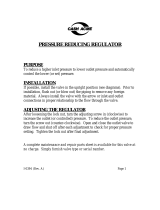 Cash Acme 23148 Installation guide
Cash Acme 23148 Installation guide
-
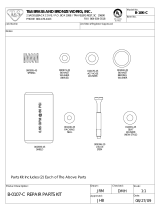 T & S Brass & Bronze Works B-10K-C Datasheet
T & S Brass & Bronze Works B-10K-C Datasheet
-
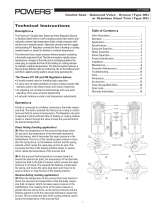 Powers Process Controls 6504235 Installation guide
Powers Process Controls 6504235 Installation guide
-
Dwyer Series 38R User manual
-
 FNW FNW651BL Installation guide
FNW FNW651BL Installation guide
-
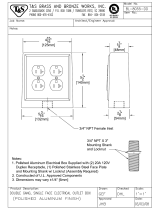 T & S Brass & Bronze Works BL-8055-DD Datasheet
T & S Brass & Bronze Works BL-8055-DD Datasheet
-
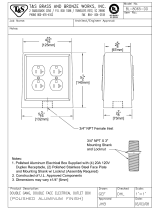 T & S Brass & Bronze Works BL-8065-Dd Datasheet
T & S Brass & Bronze Works BL-8065-Dd Datasheet
-
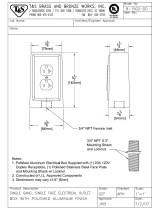 T & S Brass & Bronze Works BB-1502-DD Datasheet
T & S Brass & Bronze Works BB-1502-DD Datasheet
-
Ham-Let Valves & Fittings 3000450 Installation guide
-
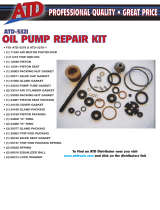 ATD Tools ATD-5321 User manual
ATD Tools ATD-5321 User manual























